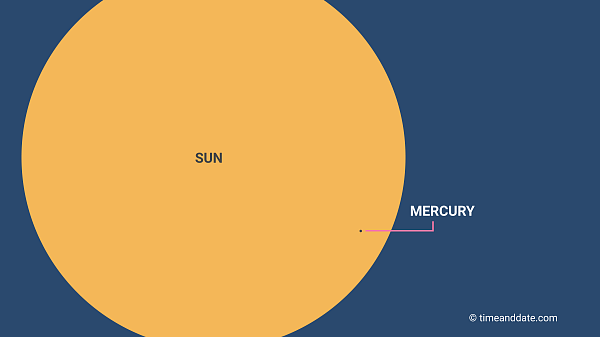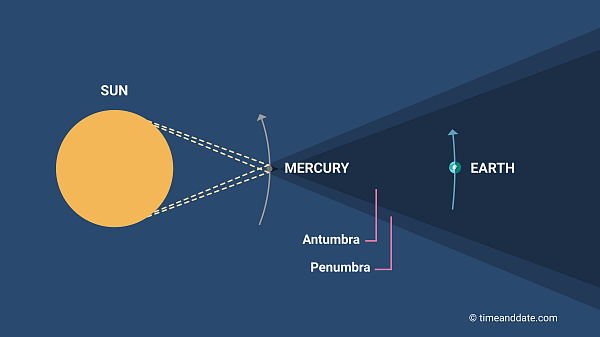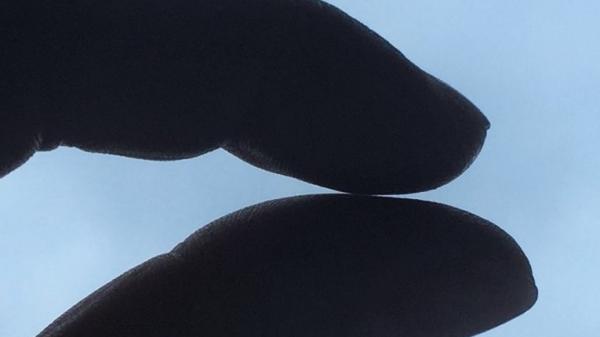Transit of Mercury
When Mercury transits the Sun, you can see it as a tiny black dot silhouetted against the Sun's disk. The last Mercury transit was on November 11/12, 2019, the next one is on November 12/13, 2032.


Mercury as a tiny dot in front of the Sun.
What Is a Transit?
Every so often, a planet lines up in a way that blocks out part of the Sun's rays from reaching Earth. This is known as a planet transit.
The only two planets that can be seen transiting the Sun from Earth are Venus and Mercury because they are the only planets that orbit inside Earth's orbit.
Picture gallery: Transit May 9, 2016
Use Telescope or Binoculars


A transit of Mercury. (Illustration not to scale.)
Because Mercury is so small and far away from Earth, you need a telescope or binoculars with a proper Sun filter to see it.
Never look directly at the Sun without proper eye protection. You can seriously hurt your eyes and even go blind.
Anywhere the Sun is up while it is in progress, people have a chance to see Mercury make its transit across the Sun's disk, weather permitting, of course.
How Often Do They Happen?
From 2000–2199, there will be 27 transits of Mercury. However, Venus transits are even rarer with only two this century, in 2004 and 2012.
Transits of Mercury this century can happen May 7–10 and November 7–14. The November transits occur about twice as often as May ones.
This is because during a May transit, Mercury is close to aphelion – furthest away from the Sun – whereas during a November transit, it is closest to the Sun, at perihelion. This is also why Mercury appears a fraction larger during May transits.
Transits of Mercury are gradually shifting to later in the year. Before 1585, they occurred in April and October.
Predicted by Kepler
German astronomer Johannes Kepler (1571–1630) first predicted that a Mercury transit would take place at the end of May 1607. On May 28, 1607, Kepler did observe a black spot on the Sun using a makeshift camera obscura. However, what he saw was a sunspot. But at the time, European astronomers were not aware of these imperfections on the Sun and explained them as planet transits. When astronomers later discovered sunspots using telescopes, Kepler realized his mistake and published a retraction.
The next Mercury transit he predicted would take place on November 7, 1631, but he did not live to see it happen. Astronomers all over Europe prepared to observe the event, but due to bad weather, only French astronomer Pierre Gassendi (1592–1655) was able to see this transit, the year after Kepler died.
Black Drop Effect
In the past, observers watching Venus transits have reported seeing a small black shape of a teardrop, which appears to connect the blackened disk of Venus to the visual edge of the Sun.
The black drop effect was initially believed to be caused by Venus' thick atmosphere. However, this theory was abandoned when the effect was also observed during the Mercury transit in 1999 because Mercury has no significant atmosphere.
Today, astronomers believe the effect is partly due to diffraction, the fact that light waves bend around the corners of an obstacle, and a kind of smearing caused by imperfections in viewing apparatuses. As telescopes and lenses have improved over time, the black drop effect has lessened.

Diffraction bends the light waves.
©timeanddate.com
Transit, Eclipse, or Occultation?
During a transit, Earth travels through a planet's antumbra, which is one of its three shadows.
When the Moon blocks the sunlight from reaching us on Earth, it is called an occultation or an eclipse.
Occultation means blocked from view entirely, while eclipse is a broader term. It can mean occultation but also to dim or partially obscure, like during a lunar eclipse.
The Moon is the only object large enough and close enough to Earth that it can completely cover the Sun's disk from view. A total solar eclipse is effectively the same as the Moon occulting the Sun.




